Table of Contents
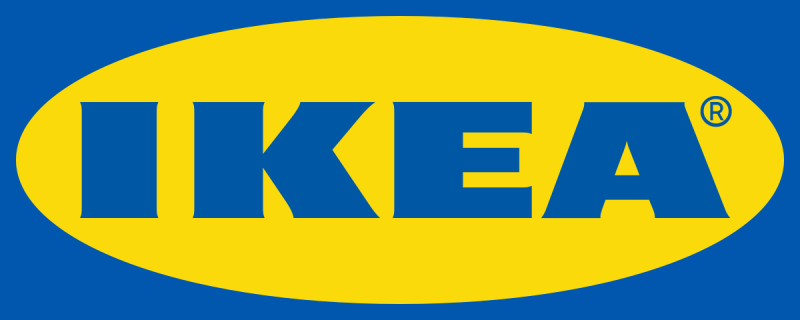
IKEA, the Swedish furniture giant, continues to stand as a global benchmark for innovation, sustainability, and affordability in 2026. With 480+ stores in 63 countries and annual revenue exceeding €47.6 billion, IKEA has transformed from a small mail-order business into the world’s largest home furnishings retailer.
This IKEA case study offers a complete business analysis that explores the company’s SWOT and PESTEL frameworks, marketing strategy, ethical initiatives, and global expansion blueprint. From its humble beginnings in rural Sweden to its digital transformation and sustainability goals, IKEA’s journey demonstrates how strong values, operational efficiency, and customer-centered innovation can create a lasting competitive edge. Students or professionals looking to create similar analyses can explore case study help for expert guidance and step-by-step support.
The story of IKEA begins in 1943, when Ingvar Kamprad, at just 17 years old, founded the company in the small village of Småland, Sweden. The name “IKEA” is derived from his initials (Ingvar Kamprad), his family farm (Elmtaryd), and his hometown (Agunnaryd).
In its early years, IKEA sold small household items like pens, wallets, and picture frames through a mail-order catalog. Kamprad’s entrepreneurial vision quickly evolved when he realized the potential of offering stylish, functional furniture at prices ordinary people could afford.
This vision was rooted in Kamprad’s now-famous principle — “To create a better everyday life for the many people.” His idea disrupted the traditional furniture industry by emphasizing flat-pack designs, self-assembly, and affordable production. The approach minimized shipping costs, reduced inventory waste, and empowered customers to participate in the product experience.
By the 1950s, IKEA had launched its first flat-pack table, Lövet, marking the birth of a retail model that blended design innovation, cost efficiency, and user engagement — elements that still define IKEA’s success today.
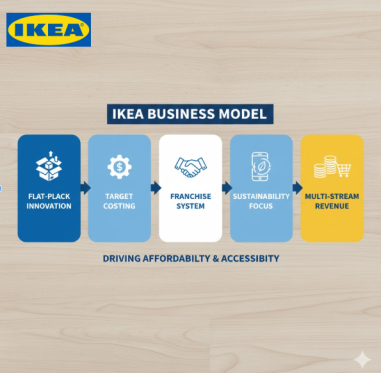
At the core of IKEA’s success lies its price-leadership business model, designed to deliver stylish and functional home furnishings at the lowest possible cost. This model integrates target costing, supply chain efficiency, and mass production to make quality design affordable for everyone.
Key pillars of the IKEA business model include:
Multi-Stream Revenue – Approximately 90% from furniture sales, 5–8% from food services, and the remainder from franchise and online operations.
This IKEA business model emphasizes “democratic design”, balancing form, function, quality, sustainability, and price. It has allowed IKEA to dominate the global furniture market while maintaining customer trust and long-term profitability.
Students can learn how to write a case study by using IKEA as an example of operational excellence.
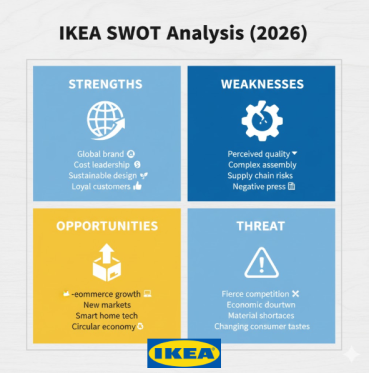
A SWOT analysis—Strengths, Weaknesses, Opportunities, and Threats—highlights IKEA’s strategic position in the global home-furnishings industry.
| Strengths | Weaknesses |
|---|---|
| Strong global brand equity – IKEA ranks among the top furniture retailers worldwide, with over 480 stores across 63 countries. | Product assembly challenges – Many customers still find IKEA’s do-it-yourself furniture difficult to assemble. |
| Cost leadership model – Through efficient supply chain management and flat-pack innovation, IKEA maintains low prices while preserving quality. | Limited customization – Standardized products can restrict personalization for local tastes. |
| Sustainability commitment – 60% of materials are renewable or recycled; IKEA aims to be fully circular by 2030. | Supply chain disruptions – Global shipping delays and raw-material shortages can impact pricing and inventory. |
| Innovative retail experience – Immersive showrooms, AR apps, and in-store dining enhance engagement. | Dependence on European suppliers – Heavy reliance on regional partners affects agility in some markets. |
| Opportunities | Threats |
|---|---|
| Urban micro-stores and online expansion – Compact city formats and digital commerce create new growth channels. | Intensified competition – Online retailers like Amazon and Wayfair threaten market share. |
| Emerging markets – Entry into Vietnam, New Zealand, and Peru expands customer reach. | Environmental regulation costs – Sustainability compliance may increase operational expenses. |
| Smart-home integration – Collaboration with tech brands could diversify product lines. | Changing consumer behavior – Minimalism and fast-furniture trends may reduce demand cycles. |
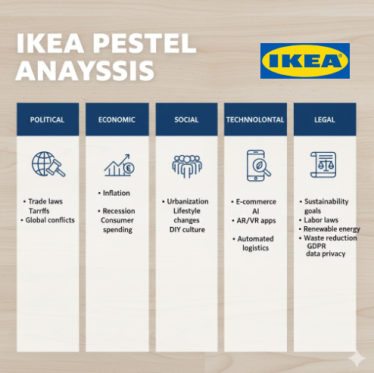
The PESTEL framework identifies external forces shaping IKEA’s strategic environment.
| Factor | Analysis |
|---|---|
| Political | IKEA operates within strict trade and labor regulations across multiple regions. EU sustainability directives and import tariffs influence sourcing decisions and supplier partnerships. |
| Economic | Inflation and fluctuating logistics costs affect profit margins. Yet, cost-efficient flat-pack designs help IKEA maintain price leadership even during downturns. |
| Social | Growing urbanization and a preference for sustainable living align with IKEA’s mission. Millennials and Gen Z value affordability, eco-friendly materials, and DIY creativity. |
| Technological | Digital tools like the IKEA Place AR app and virtual showrooms elevate customer experience. IKEA invests heavily in automation and data analytics to optimize logistics. |
| Environmental | IKEA aims to become climate-positive by 2030 by expanding renewable materials, reducing packaging, and accelerating recycling programs. |
| Legal | Compliance with international labor laws, anti-corruption policies, and product-safety standards is essential. GDPR and global data-privacy regulations shape online operations. |
Also Read: Apple SWOT/PESTEL analysis
Insight: IKEA’s focus on renewable resources, circular production, and technology integration ensures long-term resilience against macro-environmental pressures.
IKEA’s marketing strategy centers on democratic design, affordability, and emotional storytelling. Anyone documenting marketing strategies should ensure originality by using a plagiarism checker.
Target Audience
IKEA targets value-conscious consumers aged 16–45, spanning:
Eco-aware customers preferring sustainable and minimalist living.
This mix supports IKEA’s mono-segment positioning (affordable design for the many) and adaptive positioning (local adjustments for cultural relevance).
Multi-Channel Presence – IKEA reaches customers via its website, mobile app, social media, catalogs, and in-store experiences.
Content and Storytelling – Campaigns like “BookBook” and “Where Life Happens” use humor and emotion to humanize the brand.
Sustainability Messaging – Advertising emphasizes renewable materials, upcycling, and energy-efficient products.
Localized Marketing – Each region adapts visuals, pricing, and communication styles to reflect cultural norms while retaining global consistency.
Digital Experience – The AR-based IKEA Place app and personalized email campaigns improve conversion rates and online engagement.
IKEA’s marketing strategy succeeds because it links purpose and practicality—selling not just furniture, but a vision of accessible, sustainable living. This coherence across channels builds trust and loyalty among its core audience.
IKEA’s creative advertising campaigns have played a key role in shaping its identity as a fun, relatable, and purpose-driven brand. Each campaign combines humor, emotion, and real-world practicality to strengthen the bond between the brand and its customers.
| Campaign | Year | Objective & Outcome |
|---|---|---|
| Pregnancy Test Ad | 2018 | Featured a detachable section that worked as a pregnancy test. If positive, customers received a discount on baby cribs. The ad won multiple creative awards and went viral. |
| BookBook Campaign | 2015 | Parodied Apple’s tech launches by promoting the IKEA catalog as a “revolutionary device.” Generated millions of YouTube views and elevated IKEA’s humorous brand tone. |
| Paris Subway Installation | 2010 | Transformed Paris Metro stations into IKEA-style living rooms. Boosted local sales and increased footfall significantly. |
| Moving Day (Quebec) | 2013 | Distributed free IKEA-branded moving boxes that doubled as coupons, blending utility with creativity and engaging first-time movers. |
| Where Life Happens | 2017 | Story-driven campaign focusing on real-life emotional situations (divorce, conflict, stress), showing IKEA products in authentic daily contexts. |
| Don’t Forget the Meatballs | Ongoing | Highlights IKEA’s food culture to enhance the in-store experience and make shopping more enjoyable. |
Insight: IKEA’s marketing success comes from its human-centric creativity — transforming furniture advertising into storytelling that reflects daily life, humor, and empathy.
Like many global corporations, IKEA has faced ethical challenges — the most notable being its 1990s child labor controversy in South Asia. The issue became a turning point that redefined IKEA’s approach to sustainability and corporate responsibility.
In 1994, a Swedish documentary revealed instances of child labor in the Pakistan and India rug industries, some linked to IKEA suppliers. The brand faced public criticism for failing to monitor its extended supply chain.
Instead of withdrawing entirely, IKEA took accountability by launching a multi-stage ethical reform.
Ethical Reflection
These reforms transformed IKEA from a reactive brand to a leader in ethical supply chain management. Today, IKEA’s policies serve as benchmarks in global business ethics courses.
Insight: IKEA’s journey shows that transparency, accountability, and sustained investment in human rights can turn a corporate crisis into a long-term reputation advantage.
From a small Swedish mail-order firm to a global retail empire, IKEA’s expansion strategy has relied on innovation, cost efficiency, and customer insight. For students analyzing such strategies, this example can serve as a practical guide for understanding project planning, resource allocation, and execution—key concepts often explored in assignments. Analyzing IKEA’s growth offers practical lessons in project planning. You can do my project management assignment with expert guidance to apply these strategies effectively.
| Phase | Period | Strategy Focus | Impact |
|---|---|---|---|
| Foundation | 1943–1970 | Flat-pack innovation, affordable design | Established unique cost advantage |
| Expansion | 1970–2000 | Entry into Europe, Asia, North America | Became global leader in home furnishings |
| Digital Integration | 2000–2020 | E-commerce, supply chain tech, sustainability | 400+ stores, 30M+ digital customers |
| Transformation | 2021–2026 | Urban stores, digital AR tools, circular business model | 480+ stores, stronger online revenue |
Insight: IKEA’s growth blueprint rests on simplicity, cost control, and sustainability, proving that responsible innovation can drive global expansion without compromising core values.
IKEA leads the global home-furnishings market, but its dominance is continually challenged by digital-first and multi-category rivals. The following snapshot compares IKEA’s strategic position against key competitors in 2026.
| Competitor | Business Focus | Competitive Strengths | IKEA’s Advantage |
|---|---|---|---|
| Amazon | Online retail & logistics | Speed, personalization, massive reach | In-store experience, design expertise, brand trust |
| Wayfair | E-commerce furniture | Vast online catalog, data-driven UX | Physical showrooms, stronger brand loyalty |
| Home Depot / Lowe’s | Home improvement & décor | DIY audience, service support | Scandinavian design aesthetic, affordability |
| Ashley Furniture | Traditional furniture retail | U.S. market strength | Global presence, cost leadership |
| Local Retailers | Regional niche markets | Cultural customization | Global supply chain & sustainability appeal |
IKEA currently commands over 10 % of the global furniture retail market and remains the largest home-furnishings brand by revenue (€47.6 billion, FY 2024). Its balance of affordability, sustainability, and design consistency continues to differentiate it from purely digital competitors.
The company’s hybrid model—physical showrooms enhanced by digital tools—creates a moat that purely online sellers have struggled to replicate.
Insight: IKEA’s strategy of blending in-store inspiration with digital convenience has preserved its leadership even as shopping behaviors move online.
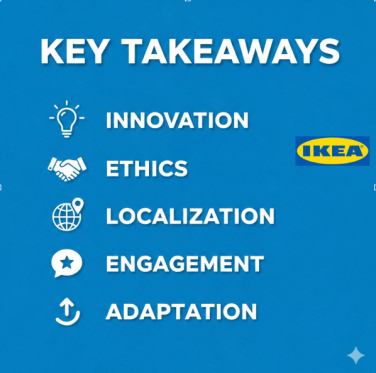
The IKEA Case Study (2026) illustrates how vision, discipline, and empathy can turn a small mail-order venture into a global design phenomenon.
Through a combination of SWOT-based self-assessment, PESTEL-driven awareness, and a marketing approach rooted in creativity and social responsibility, IKEA continues to shape the future of retail.
Its founder Ingvar Kamprad’s principle—“To create a better everyday life for the many people”—remains the guiding force behind every product, policy, and partnership.
As the company moves toward 2030, its focus on circular design, urban expansion, and digital transformation positions it to remain the industry benchmark for sustainable, affordable living.
The IKEA 2026 case study provides an in-depth analysis of IKEA’s SWOT and PESTEL frameworks, marketing strategy, ethical initiatives, corporate social responsibility (CSR), and global growth blueprint. It highlights how the company balances affordability, sustainability, and innovation to maintain its global leadership.
IKEA’s business model emphasizes cost efficiency, flat-pack self-assembly, target costing, and global supply chain optimization. By balancing affordability, sustainability, and design, IKEA has scaled globally while maintaining brand trust and customer loyalty.
Strengths: Strong global brand, cost leadership, sustainability commitment, innovative retail experience.
Weaknesses: Product assembly challenges, limited customization, supply chain dependency, occasional disruptions in logistics.
IKEA’s marketing strategy combines democratic design, storytelling, sustainability messaging, localized campaigns, and digital engagement through AR apps, online catalogs, and multi-channel presence. Iconic campaigns like BookBook and Where Life Happens humanize the brand and connect with customers emotionally.
IKEA faced a child labor controversy in the 1990s, which led to the creation of the IWAY Code of Conduct, partnerships with UNICEF and Save the Children, regular audits, and investment in education. These reforms transformed IKEA into a benchmark for ethical supply chain management.
IKEA’s PESTEL factors include:
IKEA is expanding in emerging markets like Vietnam, Peru, and New Zealand, investing in urban micro-stores, strengthening omnichannel integration, and increasing sustainability initiatives to drive global growth.
IKEA combines physical showrooms with digital tools, democratic design, sustainability, and self-assembly innovation, creating an experience that purely online retailers cannot easily replicate. Its global supply network and local adaptability provide additional competitive advantage.